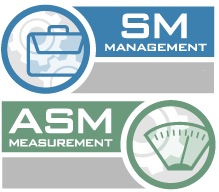SM/ASM 2001 - Software Management & Applications of Software Measurement

PRESENTATIONS
|
Enterprise-Wide Change and Configuration Management
Multi-tier applications are increasingly strategic for many organizations, but manually coordinating the movement of disparate components-developed and deployed on multiple platforms through the software development lifecycle-can be tedious and error-prone. Learn the key features to look for in a solution and how to ensure the highest quality multi-tier applications. Explore the business and technical challenges involving changes in enterprise applications. |
|
|
Estimating in the Web World
Discover the techniques used by estimators to overcome the challenges they are confronted with in attempting to estimate totally new development environments in the Web/e-commerce world. Typical challenges include how to scope functionality, assess realistic developer efficiency, and tailor the lifecycle processes. Learn how to use these techniques to estimate new project environments and effectively communicate the results of your analysis. Case studies will be provided to illustrate the techniques and their practical application. |
|
|
Estimating Software Productivity and Quality on Large Systems
Estimating productivity (e.g., lines of source code developed per hour) and quality (e.g., code defect rates) are difficult on large software projects that involve several companies or sites, emphasize reuse of Commercial-Off-The-Shelf (COTS) components or adaptation of legacy code, and require open architectures. Using actual metrics from such software development projects, this paper illustrates problems encountered and lessons learned when measuring productivity and quality. |
|
|
Experiences with Global Software Architecture Design and Development
In this paper, we describe our experience designing and developing a system-for acquiring and processing data from electric, gas, and water meters-among four development sites located in Switzerland, Germany, and the U.S. Some of the techniques we used for project planning and management are described. We observed that a number of multicultural variables affect the overall performance of the development team. Based on our experience, a set of recommendations is given for managing global software development teams. |
|
|
Extreme Programming and CMM
This presentation explains the Capability Maturity Model and Extreme Programming, compares the two, and shows how they can be compatible. |
|
|
eXtreme Programming Meets Measurement
With the Internet explosion creating new "e-somethings" daily, and society embracing X-anything, it should come as no surprise that eXtreme Programming is the latest concept to hit IT. Forget the visions of IT managers projecting themselves off a cliff with bungee cords and a laptop-eXtreme Programming is more mainstream than renegade, offering a mixture of old and new, tried and true all bundled into one. Learn what eXtreme Programming is all about and how it differs from other development methodologies. |
|
|
Facilitated Workshops in Software Development Projects
To build planning and requirements products quickly and efficiently, consider using facilitated workshops. In your workshops, participants should be active, engaged, |

Ellen Gottesdiener, EBG Consulting, Inc. |
|
From Zero to 100: Project Metrics in an Investment Bank
Metrics collection, interpretation, and data quality always present a challenge to organizations. In the midst of an ever-increasing organization such as Goldman Sachs, the need for comprehensive metrics has become a top priority. Learn how one company successfully implemented a measurement initiative from ground zero using project management discipline, completion dates, scope definition, and a lifecycle approach-resulting in expanded coverage, more sophisticated usage of data, and support of the management and quality teams. |
|
|
Gaps, Traps, and Overlaps: Communication Flaws and How to Fix Them
In some organizations, communication flaws are rampant and muddled messages are the norm. Success in software efforts is often hindered by communication that is incomprehensible, ambiguous, misdirected, ill-timed--or lacking when it is most needed. The result? Rocky relationships, topsy-turvy teamwork, precarious projects, and crazed customers. The situation is not hopeless, though. In fact, making changes is surprisingly easy. |
|
|
Is That Your Final Answer? Auditing Your Measurement Program
More and more organizations are committed to establishing an effective measurement program. Big or small, measurement takes time and resources. The overriding key to measurement program success is accuracy. Organizations with established metrics programs typically institutionalize an audit activity to maximize their investment. Explore the current approaches being used to audit measurement activity. Learn why auditing is so important, and what and when to audit within your organization. |

David Herron, The David Consulting Group |


